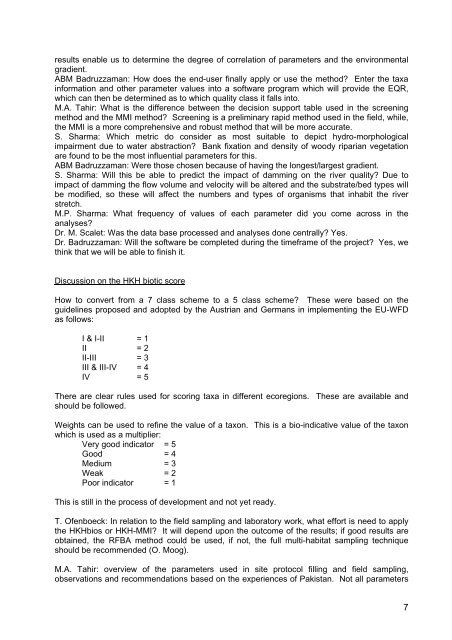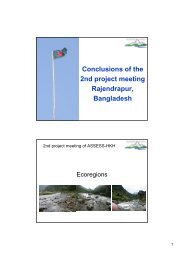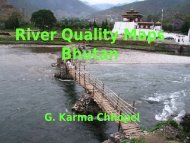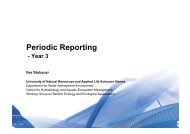2007 - ASSESS-HKH
2007 - ASSESS-HKH
2007 - ASSESS-HKH
Create successful ePaper yourself
Turn your PDF publications into a flip-book with our unique Google optimized e-Paper software.
esults enable us to determine the degree of correlation of parameters and the environmental<br />
gradient.<br />
ABM Badruzzaman: How does the end-user finally apply or use the method Enter the taxa<br />
information and other parameter values into a software program which will provide the EQR,<br />
which can then be determined as to which quality class it falls into.<br />
M.A. Tahir: What is the difference between the decision support table used in the screening<br />
method and the MMI method Screening is a preliminary rapid method used in the field, while,<br />
the MMI is a more comprehensive and robust method that will be more accurate.<br />
S. Sharma: Which metric do consider as most suitable to depict hydro-morphological<br />
impairment due to water abstraction Bank fixation and density of woody riparian vegetation<br />
are found to be the most influential parameters for this.<br />
ABM Badruzzaman: Were those chosen because of having the longest/largest gradient.<br />
S. Sharma: Will this be able to predict the impact of damming on the river quality Due to<br />
impact of damming the flow volume and velocity will be altered and the substrate/bed types will<br />
be modified, so these will affect the numbers and types of organisms that inhabit the river<br />
stretch.<br />
M.P. Sharma: What frequency of values of each parameter did you come across in the<br />
analyses<br />
Dr. M. Scalet: Was the data base processed and analyses done centrally Yes.<br />
Dr. Badruzzaman: Will the software be completed during the timeframe of the project Yes, we<br />
think that we will be able to finish it.<br />
Discussion on the <strong>HKH</strong> biotic score<br />
How to convert from a 7 class scheme to a 5 class scheme These were based on the<br />
guidelines proposed and adopted by the Austrian and Germans in implementing the EU-WFD<br />
as follows:<br />
I & I-II = 1<br />
II = 2<br />
II-III = 3<br />
III & III-IV = 4<br />
IV = 5<br />
There are clear rules used for scoring taxa in different ecoregions. These are available and<br />
should be followed.<br />
Weights can be used to refine the value of a taxon. This is a bio-indicative value of the taxon<br />
which is used as a multiplier:<br />
Very good indicator = 5<br />
Good = 4<br />
Medium = 3<br />
Weak = 2<br />
Poor indicator = 1<br />
This is still in the process of development and not yet ready.<br />
T. Ofenboeck: In relation to the field sampling and laboratory work, what effort is need to apply<br />
the <strong>HKH</strong>bios or <strong>HKH</strong>-MMI It will depend upon the outcome of the results; if good results are<br />
obtained, the RFBA method could be used, if not, the full multi-habitat sampling technique<br />
should be recommended (O. Moog).<br />
M.A. Tahir: overview of the parameters used in site protocol filling and field sampling,<br />
observations and recommendations based on the experiences of Pakistan. Not all parameters<br />
7






